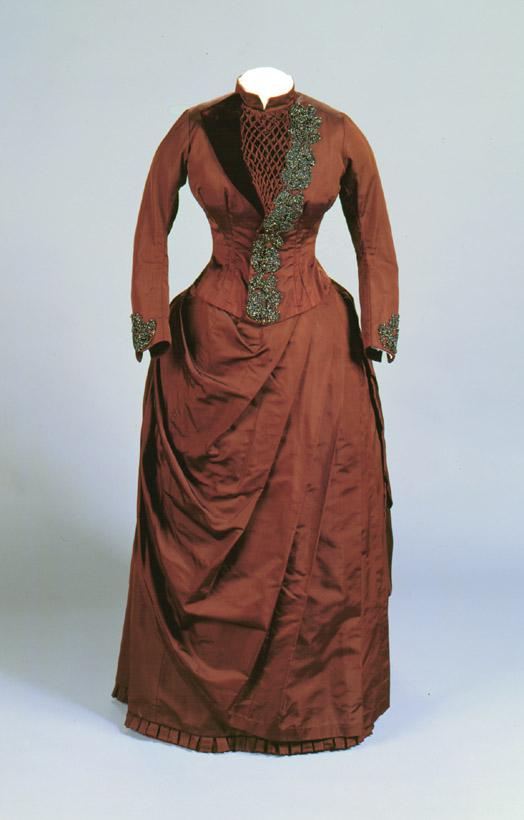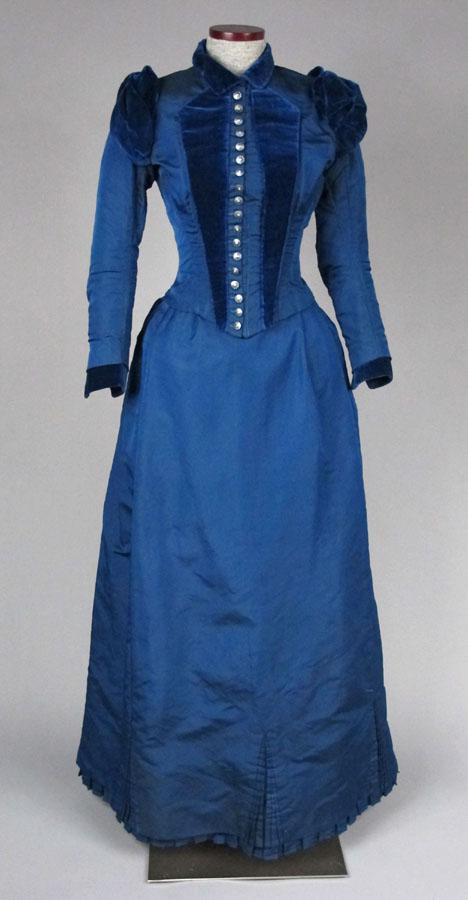Wedding Dress
Original OwnerOriginally owned by
Ella Clarinda Pitkin
(American, 1860 - 1949)
Clothing MakerMade by
Ella Clarinda Pitkin
(American, 1860 - 1949)
Date1888
MediumMachine-stitched and hand-stitched silk and cotton, with wool hem tape, glass beads, ferrous metal hooks and eyes, and steel boning
DimensionsBodice (center back length x width across shoulders): 22 x 13 1/4in. (55.9 x 33.7cm)
Skirt (hem circumference x length): 89 1/2 x 40 3/4in. (227.3 x 103.5cm)
ClassificationsCostume
Credit LineGift of Mr. and Mrs. Edward C. Allen II
Object number2003.18.1a,b
DescriptionWoman's formal dress of dark brown silk faille, consisting of a bodice (.a) and a skirt (.b). The bodice has a high, round neckline with a 1 1/4-inch high standing collar. The bodice front is assymetrical, overlapping to the proper right shoulder. This right side of the bodice front is smocked below the neckline in a triangular configuration, extending with a panel of brown velvet, which hooks below the right shoulder. Along the proper left side of the bodice is a 2 3/4-inch-wide appliqué of bronze-colored beads, worked in a stylized leaf design. The bodice opening extends for the length of the center front and fastens with hooks and eyes; the opening is covered from the center of the bodice to the neck with the smocked and velvet extension of the right side. The shoulderline is at the natural height; the two-piece sleeves are tight-fitting and slightly curved. They are decorated at the wrist opening with an appliqué of the bronze beads and a triangle of the velvet at the opening of the outside seam. The waist of the bodice is dipped at center front. Two 9 1/4-inch darts on each side of the front provide fit, while the back is fitted by being constructed of six pattern pieces. The bottom corners of the side back panels appear to turn up, revealing triangles of velvet. The bodice is lined with brown twill-woven cotton. The seams are boned with steel strips encased in tan-colored twill-woven cotton, held in place with orange herringbone stitches worked in an overlapping double row. Two extensions at the center front opening, made of the brown lining fabric, hook together to provide extra stability at the waistline.
The skirt is assymetrically draped, with the fabric pleated up to the proper left hip in front. The fabric is pleated differently over each hip. The center back of the skirt is constructed in a panel which ties with silk tapes around the waist, over the hook and eye closure of the skirt waistband. This center back panel is knife-pleated towards the center, with puffs of fabric on either side, created by folding and tacking the fabric in place. A 1 1/2-inch wide ruffle of box-pleated self-fabric borders the bottom of the skirt. The skirt is lined with glazed brown cotton, with a nine-inch deep lining around the bottom of heavy, coarse, stiff, dark brown cotton. The bottom edge of the skirt is finished with brown wool hem tape. The skirt lining in back is gathered along a strip of steel, with the ends connected by a buckled elastic strap, to control the skirt fullness towards the back and create a bustled effect.
NotesHistorical Note: Ella Clarinda Pitkin (1860-1949) married Edward Channing Allen (1853-1933) on Wednesday, 12 September 1888, in South Windsor, Connecticut. Ella Pitkin was a seamstress, and she made her own wedding dress. The Allens ran a general store in Hazardville, Connecticut.The skirt is assymetrically draped, with the fabric pleated up to the proper left hip in front. The fabric is pleated differently over each hip. The center back of the skirt is constructed in a panel which ties with silk tapes around the waist, over the hook and eye closure of the skirt waistband. This center back panel is knife-pleated towards the center, with puffs of fabric on either side, created by folding and tacking the fabric in place. A 1 1/2-inch wide ruffle of box-pleated self-fabric borders the bottom of the skirt. The skirt is lined with glazed brown cotton, with a nine-inch deep lining around the bottom of heavy, coarse, stiff, dark brown cotton. The bottom edge of the skirt is finished with brown wool hem tape. The skirt lining in back is gathered along a strip of steel, with the ends connected by a buckled elastic strap, to control the skirt fullness towards the back and create a bustled effect.
Status
Not on view






















